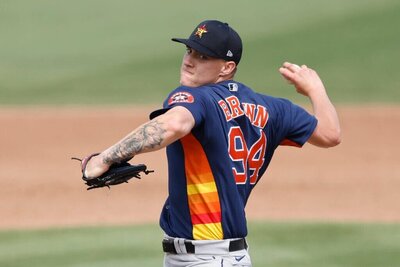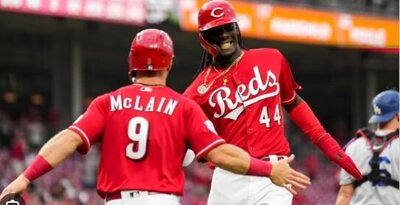Stephen Drew- The Boston Red Sox announced on Tuesday the re-signing of Stephen Drew for the remainder of the 2014 season. Drew is expected to spend 7-10 days in the minor leagues getting up to speed prior to making his debut for the Sox. Fantasy owners can probably expect slightly less production than in 2013 from Drew. By the time he gets called up, Drew will have missed between 51-55 games of the Red Sox season and will almost assuredly be switching positions to take over the void that has been 3rd base for the reigning world champs. The good news is fantasy owners in desperate need of infield depth should get a player with shortstop eligibility who will soon acquire 3rd base as well. The expectation should be approximately 10 home runs, 4-5 steals and a .250 average from Drew the rest of the way. This isn't anything to write home about, but if you are desperate for a warm body with his specific position eligiblity, Drew will serve that purpose. His 10.8% BB Rate in 2013 is supported by his larger sample size, and his .320 BABIP is not wildly out of place with other full season numbers during his career meaning his .253 average probably won't regress wildly. I'm not advising adding Drew in anything but the deepest mixed formats (16 team+), but he may have some nice value as an addition to AL-Only rosters at the quarter season mark especially given his likely multi-position eligibility.
Juan Francisco- There might not be a more prime category for negative regression early on in the season than Juan Francisco. Specifically, Francisco's .292 batting average is not long for this world. The Blue Jays 3rd baseman/DH has two fairly obviously outliers that can pretty quickly tell us that some hitless games are in his near future. First, Francisco is carrying a .391 BABIP, which is 75 points higher than his 3 year average. If you've seen Mr. Francisco play, you know that this isn't a case of him legging out more ground balls than in the past. They measure his time to first with a sun dial so this is more just lucky placement. Second, his K Rate is in line with his last two seasons at an atrocious 35.3%. As such, we can expect a fairly large drop of in his average (think 40-50 points). Even with him being used primarily against right handed pitching, the .292 can't be supported. That's the bad news. The good news is that his power, while not quite as spectacular as we have seen this month, should remain mostly intact. His HR/FB Rate of 36.4% is, frankly, unsustainable, but his two year prior years support an elite HR/FB rate for Francisco (22.5% in 2012, 23.1% in 2013) so the regression should still leave owners with a fair chance at 20 or more home runs depending on his at bats (he is smartly being used almost exclusively against RHP where he succeeds far more often than against southpaws).
Brandon Moss- There may not be a better role model for the age of the platoon than Brandon Moss. Moss has actually hit very well against both handed pitchers so far in 2014, but his team has wisely tried to limit Moss to killing right handed pitching. Whomever he is hitting against, he is proving fantasy owners that took a chance on this platoon monster very, very wise. Moss is currently experiencing his best season as a pro ball player, which is due in no small part to his ability to limit his strike outs. Moss' 18.3% K Rate is his lowest rate since becoming a major league player and is a 9.4% drop from 2013 and a 12.1% drop from 2012. The best news for Moss is that he is swinging at the same percentage of pitches he did in 2013 (50.6%), but his Swinging Strike Rate is down 3.1% (from 14.6% to 11.5%) and he is making a ton more contact. This is a really strong sign for fantasy owners because Moss is an aggressive fly ball hitter with strong HR/FB rates over the past three seasons (25.9% in 2012, 18.8% in 2013 and 17% in 2014). The more contact he makes, the more balls he puts in the air and the more balls he puts in the air, the more balls leave the yard. Pretty simple formula, but it is so rare when it all comes together like it has for Moss at this point. Less strike outs and more contact= an extremely valuable fantasy asset. Fantasy owners should expect to see the strike outs increase slightly, but it shouldn't be so extreme as to damper the fantastic results we have seen so far from Moss.
Victor Martinez- It is rare, but sometimes, a batting eye gets better with age. Certainly, Victor Martinez can attribute more than a little bit of his spectacular 2014 to a 5.3% K Rate. V-Mart has always been a tough player to strike out. His career high 12.5% K Rate is miniscule compared to some of the 30+% K Rates we see in the game, but this year's rate is a career best even for Martinez. He has maintained a stellar 3.1% Swinging Strike Rate which is supported by his extended three year sample as being truly representative of his skill set. There is a bit of justification that his .329 batting average may even increase as his .289 BABIP is slightly understated given his career averages although a regression to his career mean on K Rate could even that out. In either case, there is a high likelihood that Martinez will continue to be a .300 hitter for the remainder of the season. The continuation of his power display, however, is less likely. V-Mart is currently carrying a 19.3% HR/FB rate, which would a career high rate in his age 35 season. It seems unlikely that Martinez would experience an almost 6% spike in this rate given his age. I'd expect a negative regression meaning that less balls will leave the yard moving forward. He should still be on pace to hit around 25 home runs, but I do not expect him to go far beyond that. This is still ridiculous value given his placement in a potent Tigers lineup and his ability to hit for average.
Eric Hosmer- I wanted to touch a bit on Eric Hosmer after Paul wrote him up yesterday. Paul mentioned yesterday that we are seeing Hosmer hit more fly balls this year as his Fly Ball Rate is up from 24.9% to 33.1%, and he, then, correctly pointed out that this increase in fly balls isn't actually helping as much as it should because of a 2.0% HR/FB rate. I wanted to dig a bit further. While Hosmer is hitting more fly balls, Paul's point on Hosmer not hitting them for any real distance is dead on. Along with an increase of his Fly Ball Rate, Hosmer has seen two very disturbing traits. His IFFB% is up from 6.9% last season to 11.8% this season so a large percentage of the balls he is hitting are staying in the infield. On top of that, Hosmer continues to be a largely ground ball dominate hitter as he is still putting the ball on the ground in excess of 50% of the time (53.6% in 2012, 52.7% in 2013 and 52.6% in 2014). This new found loft has come not at the expense of Hosmer hitting ground balls, but rather at the expense of him hitting line drives. Hosmer's line drive rate is down from 22.4% in 2013 to 14.3% in 2014. A decrease in line drives and an increase in IFFB% all indicate that Hosmer is not squaring up the ball and making solid contact. As a fantasy owner, who has put faith in Hosmer, I'm sad to report that we aren't seeing much from him in way of figuring it out. I'm still hanging on as he is providing enough in batting average that he can be a rotational piece, but without any real power, his value is extremely tenuous in all but the deepest of leagues.
Today's American League Player Blog is brought to you by Nicholas Rossoletti. You can follow Nicholas on Twitter @NRoss56
This is just a small sample our our daily analysis, join our member area for more premium content: http://www.fantistics.com/join/join.php3


































